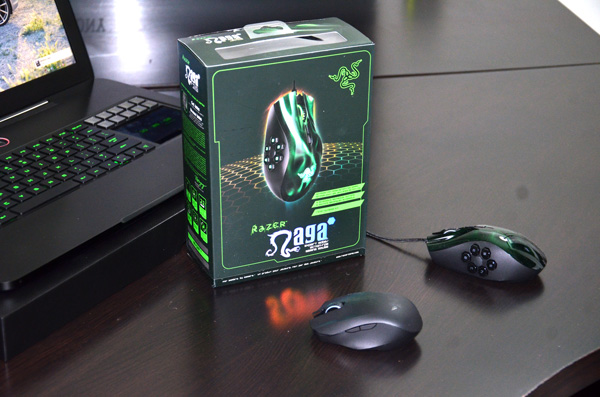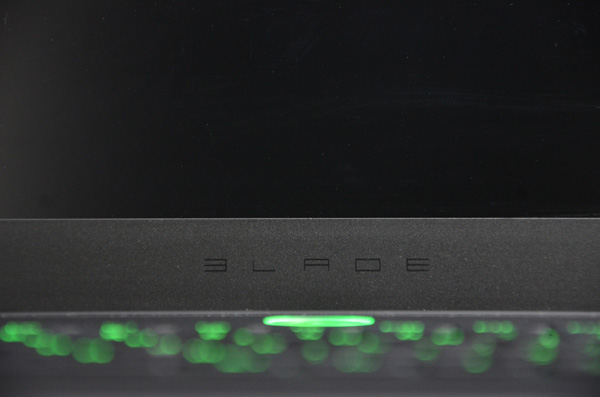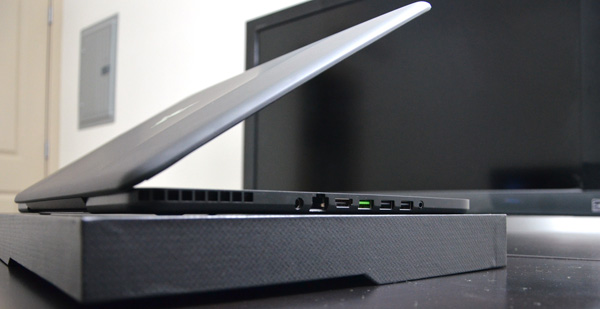The Razer Blade Review
by Vivek Gowri & Jarred Walton on March 15, 2012 3:01 AM ESTRazer is, first and foremost, a gaming company. From the company slogan (“By gamers, for gamers”), to partnerships with a number of the most popular game development studios, even the job title on the CEO’s business card (it reads Chief Gamer), nothing about Razer is shy about who the target market is. But it’s key to note that Razer is a gaming company which has focused on gaming-related peripherals and accessories—mice, keyboards, headsets, controllers, and limited edition peripherals for specific games. But that all changes as of now.
The vessel of change in question: Razer’s new Blade, a $2799 gaming laptop that bucks almost all of the common trends in gaming-focused desktop replacements. This isn’t the first time that Razer has shown intent to play in the gaming hardware space, having shown off the innovative Switchblade concept system at CES 2011. The Switchblade design concept clearly had a major influence on the Blade as is evident from the Switchblade UI panel on the side of the keyboard, but what’s important to note with the Blade is that it shows just how serious Razer is about transitioning into PC hardware and gaming systems. Read on to see how it fared.
| Razer Blade Specifications | |
| Processor |
Intel Core i7-2640M (2x2.80GHz + HTT, Turbo to 3.5GHz, 32nm, 4MB L3, 35W) |
| Chipset | Intel HM67 |
| Memory | 2x4GB DDR3-1333 |
| Graphics |
NVIDIA GeForce GT 555M 2GB GDDR5 (144 CUDA Cores, 675MHz/1350MHz/2.5GHz core/shader/memory clocks, 128-bit memory bus) |
| Display |
17.3" LED Matte 16:9 1080p AUO B173HW01 V5 |
| Hard Drive(s) | 256GB Lite-On LET-256M2S 6Gbps SSD |
| Optical Drive | - |
| Networking |
Intel Centrino Advanced-N 6230 802.11a/b/g/n Bluetooth 3.0 |
| Audio |
Realtek ALC275 HD Audio Stereo speakers Single combination mic/headphone jack |
| Battery | 6-Cell, 60Wh (integrated) |
| Front Side | - |
| Right Side | Kensington Lock |
| Left Side |
AC Adaptor Port Gigabit Ethernet HDMI USB 3.0 2 x USB 2.0 Headphone/Line-in Combo |
| Back Side | - |
| Operating System | Windows 7 Home Premium 64-bit SP1 |
| Dimensions |
16.81" x 10.90" x 0.88" (WxDxH) 427mm x 277mm x 22.4mm |
| Weight |
6.4 lbs 2.91kg |
| Extras |
2.0MP Webcam Ambient light sensor Backlit keyboard Switchblade UI Ten dynamic LCD keys 4.05" WVGA LCD touchpad (capacitive, multitouch) |
| Warranty | 1-year limited |
| Pricing | $2799 |
Heralded by Razer as the “World’s First True Gaming Laptop”, the 17” Blade is built around Intel’s Core i7-2640M and an NVIDIA GT 555M dGPU. The i7 is clocked at 2.8GHz, with a max turbo of 3.3GHz on two cores or 3.5GHz on a single core, while the GT 555M has 2GB of vRAM and clocks of 675/1350/2500 MHz for core, shaders, and vRAM, respectively. The GPU is pretty pedestrian by 17” gaming notebook standards, with the GT 555M falling somewhere between high-end mainstream and low-end gaming cards. There’s many different versions of the GT 555M, but the SKU in the Blade seems to be the most potent variant, using a cut down version of the same GF116 architecture in the GTX 560M. The rest of the specsheet is headlined by 8GB of memory and a 256GB SSD made by Lite-On. The Lite-On LET-256M2S is built around Marvell’s 88SS9174 controller, the same controller that serves as the basis for Intel’s SSD 510. Lite-On claims up to 480MB/s for sequential read and 330MB/s for sequential write speeds. The display is a 17.3” 1080p panel made by AU Optronics, but what we were most thrilled by is the beautiful matte screen finish. The Switchblade UI panel lives to the right of the keyboard and features 10 dynamic LCD keys (Art Lebdev-style) as well as a secondary display, a 4.05” 800x480 multitouch LCD that serves as the Blade’s touchpad. In addition, Razer includes a special edition of their Bluetooth mobile gaming mouse, the Orochi.
Rather impressively, Razer managed to pack all that hardware into an enclosure that’s just 0.88” thick and weighs 6.4lbs. If Intel were to extend the ultrabook hardware guidelines out to 17” notebooks, the Blade would hit them pretty dead on. The razor-thin (get it, get it?) profile explains why Razer was limited to a GT 555M—simply put, Razer couldn’t fit anything more powerful into the thermal design without significantly compromising the performance of the cooling system. But what’s noteworthy here is that Razer took the design of the Blade in completely the opposite direction of the majority of the gaming notebook world.
If you were to poll a large group of people for the best 17-18” gaming class portable on the market, you’d end up with a range of answers—Alienware’s M17x or M18x, the ASUS G74Sx, some variant of Clevo’s P170HM, possibly the MSI GT780, etc.
| Razer Blade | Alienware M17x R3 | Alienware M18x | ASUS G74SX | Clevo P170HM | MSI GT780-DXR | |
| CPU | Core i7-2640M | Core i7-2670QM | Core i7-2670QM | Core i7-2670QM | Core i7-2670QM | Core i7-2670QM |
| GPU | GT 555M | HD 6990 | GTX 560M SLI | GTX 560M | GTX 580M | GTX 570M |
| Thickness | 0.88" | 1.76" | 2.13" | 0.82-2.44" | 1.65-1.89" | 2.17" |
| Weight | 6.40lbs | 9.39lbs | 11.93lbs | 9.42lbs | 8.60lbs | 8.63lbs |
| Price | $2799 | $2049 | $2899 | $1399 | $2239 | $1699 |
Take a look at the spec table—the Blade is thinner than everything up there by at least a factor of two, as well as being at least two pounds lighter. It’s also a good deal more expensive than everything but the M18x, and a good deal less powerful. (It's worth noting that the Blade is the only one on the list with an SSD, but otherwise they're pretty similar—1080p, 8-12GB memory, etc. Factor an additional $200 to upgrade to an SSD in the other systems.) Comparing the M18x and the Blade head to head is a bit of comedy—in terms of form factor, the Blade is literally half the laptop the nearly twelve-pound M18x is. They’re both very high-end and very expensive gaming notebooks, but they couldn’t be any more different after that.
So it’s pretty clear that Razer wasn’t aiming at the gaming notebook establishment—in fact, on paper the Blade looks a bit like the Windows answer to the 17” MacBook Pro. Which isn’t to say that the 17” MBP is a competitor for the Blade in any way—the design ethos and target markets are completely different, but it’s worth noting the similarities in form factor and price, as well as the focus on premium design and overall attention to detail. In the PC world, the closest you’re going to get on paper is the HP ENVY 17, at 1.28” thick, 7.37lbs, and starting at $1249 with AMD Radeon HD 7690 XT graphics.
Where I’m going with all this is to show that the Blade is a pretty unique proposition in the notebook world—it’s a high-end 17” gaming portable that, at least in terms of hardware, focuses more on the portable than the gaming.













95 Comments
View All Comments
JarredWalton - Thursday, March 15, 2012 - link
It's funny how we have all these 3D HDTVs with IPS displays, but somehow the only 120Hz computer displays are TN panels. I suppose maybe the HDTVs only have to deal with HDMI input so they're really only doing 3D with 48Hz (Blu-ray) or 60 Hz (HDTV broadcasts). Anyway, IPS can be very good, though there are people that prefer TN because on paper the specs look better. Look at our IPS display reviews lately, and you'll see that in our real-world testing some TN panels are about 10ms faster "input lag" than IPS:http://www.anandtech.com/show/5550/dell-u2412m-16-...
I'd still go IPS given the choice.
erple2 - Thursday, March 22, 2012 - link
Wait. Are there ANY IPS based HDTVs abailable? When did that happen?shatteredx - Thursday, March 15, 2012 - link
I play fast paced shooters like ut and cs and there's no noticeable input lag or blurring on my dell u2312hm or 2007wpf. I did notice a bit of blurring on my 2007wpf for about the first week after switching from a CRT back in 2006 but my brain adjusted to it quickly.I can't stand the bad viewing angles on tn panels (which are exacerbated on laptops due to variable desk height) and my next laptop will surely have an ips panel.
I just wish a 120hz ips panel would get developed.
Dustin Sklavos - Thursday, March 15, 2012 - link
I personally love my Alienware M17x R3. It's a couple pounds heavier than the Razer Blade, sure, but it's usable. What good is a thin and light form factor for a gaming machine when the thing is obscenely noisy under load, running so hot that out of the box the processor is already near boiling, and features a keyboard that's next to impossible to type on? And then the notebook has problems with sleep mode, AND one of its major selling points is crash prone?I'm sorry, but as an alternate take, from what I've read here I can't agree with the recommendation. Looks are nothing without substance behind them.
weiran - Thursday, March 15, 2012 - link
Personally I can't see myself ever wanted to carry an Alienware M17x anywhere off my desk, and in that case I may you may as well get a desktop. Razor has attempted to make a gaming laptop that's really portable, and have done a very good job. In fact is there even a lighter 17" or even 15" laptop?I think Razor is realising that being just another competitor producing gaming slabs that compete only on spec and price makes no sense; they will have razor (ha) thin margins and just be another player in the game. By creating their own sub-category of device, appealing to a reasonable niche of gamers who want an ultraportable laptop that still has a good discrete GPU, they're in their own market with no direct competition.
I'm glad there's at least one PC manufacturer making something different, and pulling it off.
Dustin Sklavos - Thursday, March 15, 2012 - link
The problem is that if you want something lighter and more portable, the Alienware M14x offers roughly as much performance for half the price. You have to go down to a 1600x900 screen, but that resolution is also better suited to the GT 555M.Penti - Thursday, March 15, 2012 - link
Yup, that would be better and more what I would be inclined to if I where in the market for a gaming laptop. For me GT555M is bare essential minimum here. I don't like the 17" laptops at all and the DTR-models usually just fails. The cheap 1080p panels aren't really to prefer and the graphics aren't powerful enough to drive that in games any way. So I was looking at the M14x closely when it came out and do like it more. I would basically need GT555M or better, and certainly a display above 1366x768 here.Also the M14x is about 1000-1500 USD cheaper so there is really no choice here. Why spend the extra money to get something looking kinda awful and not really have any better performance. Even as gaming laptops goes it look awful. The touchpad-thing is just despicable and just something useless a company like razor could come up with.
bennyg - Thursday, March 15, 2012 - link
I think my P150HM is quite portable. It happily goes from home to office every day and fits in my reasonably-sized backpack. Its under 4kgs, looks like a Thinkpad (!!!), and has a SB quaddy and 580M in it with a cooling design that keeps the laptop cool. And has a fantastic screen (upgrade option 95% gamut matte)When you think how little you add in size and weight the m14x looks silly in comparison as a "gaming" notebook. New refresh model looks like it will add Optimus (for 580M, yes) and backlit keyboard which are really the only two weaknesses. Along with the monstrous poowerbrick... but in the office a 90W 19V does the job.
I don't know what Razer were thinking with this laptop to be honest, it just looks compromised in so many ways. Looks like a gamer-ised MBP that ate a smartphone, Borg-style.
piroroadkill - Thursday, March 15, 2012 - link
I think it's actually fantastic, and I don't have the same complaint about the keyboard layout - it looks reasonable enough to me.I love the changeable keys and the touchscreen touchpad on the right.. it means when you're gaming on the built in keyboard, you won't rest your wrist on the classic touchpad position.
The CPU choice is great, the screen choice is perfectly fine, the thickness is stunning.. Even the battery life is half decent.
The only low point is the slightly inadequete GPU. I'm no Razer fan, I think they make flashy gaming hardware that has sub-par build quality and poor support.. BUT that said, this is a fantastic looking machine, offering some genuinely fresh features into a stagnant market. Shoe-horn a slightly better GPU in there, look at some way to offer it at a cut price (maybe stick a Barracuda XT 750GB in it?), and you have an extremely compelling product.
gostan - Thursday, March 15, 2012 - link
this review is just so sad at so many levels. let's build a supercar, let's fit it with tiny wheels, and let's charge a lot of money for it. then let's get a media to justify the wheel selection..